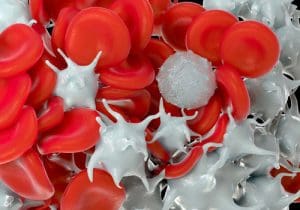 Following a community Tai Chi class last April, Charlotte Wichael’s ankle became progressively sore. “We were doing a lot of ankle movements,” recalls the Arvada resident. “My ankle got more and more sore after that class.”
Following a community Tai Chi class last April, Charlotte Wichael’s ankle became progressively sore. “We were doing a lot of ankle movements,” recalls the Arvada resident. “My ankle got more and more sore after that class.”
By the end of April, Wichael could no longer walk and rarely left home. By July, the pain had become severe. “I was almost an invalid,” she says. “My husband and I could not take trips. I could not even go shopping.”
Wichael saw her primary care physician, who referred her to an orthopedic specialist. The specialist told her that her only option was to have her ankle fused. Wichael was not ready for surgery and the long recovery period it would require. She began doing her own research. Her sister told her about platelet-rich plasma (platelet injections) therapy and suggested she schedule an appointment with Dr. George Leimbach, a physiatrist at the Center for Spine and Orthopedics.
Wichael saw Dr. Leimbach, who came to the same conclusion as her orthopedic specialist. He said that fusion was probably her best option, but that she could try platelet injections first. She scheduled a platelet injections injection for two weeks later. On December 12, a technician drew two ounces of Wichael’s blood, which was then spun for 14 minutes in a centrifuge to separate the plasma out. Dr. Leimbach then injected the plasma into Wichael’s ankle joint.
By the next morning, Wichael’s ankle felt a little bit better. Her pain continued to diminish each day for two weeks after the shot until her ankle no longer hurt. “It was amazing,” she says. “I could not believe the pain was gone. My other alternatives were rotten.”
At her follow-up visit on December 27, Dr. Leimbach recommended that Wichael use an exercise bike to regain the leg strength she has lost during nine months of inactivity. “I was strong last April,” she says. “You would not think that in only nine months, you could lose so much strength but I did.”
Now, Wichael looks forward to a trip this spring with her husband and Jeeping in the mountains this summer. She has been able to go shopping again, too. “I’m sure this is the medicine of the future,” she says. “I don’t know how it works. I just know it worked for me. I had bone on bone arthritis in my ankle and now I can walk again. I think it regrows the meniscus.”
A pilot friend of the Wichael’s also had a platelet injections injection in his elbow. “His hand was numb, and he could not fly for a week. After a second injection, he was able to fly again,” she explains.
Though insurance does not cover platelet injections injections, Wichael says it is not a big price to pay if it works. “The success rate is like 70 percent,” she says. Though rates vary by practice, the Center for Spine and Orthopedics offers one of the most reasonable rates at $750 per injection. “I am just amazed that this worked so well,” says Wichael.
About Platelet-Rich Plasma Therapy (platelet injections)
 Platelet-rich plasma therapy (platelet injections) is an increasingly common arthritis treatment. platelet injections therapy attempts to take advantage of the blood’s natural healing properties to repair damaged cartilage, tendons, ligaments, muscles or even bone. Although not considered standard practice, a growing number of people are turning to platelet injections injections to treat an expanding list of orthopedic conditions, including osteoarthritis.
Platelet-rich plasma therapy (platelet injections) is an increasingly common arthritis treatment. platelet injections therapy attempts to take advantage of the blood’s natural healing properties to repair damaged cartilage, tendons, ligaments, muscles or even bone. Although not considered standard practice, a growing number of people are turning to platelet injections injections to treat an expanding list of orthopedic conditions, including osteoarthritis.
When treating osteoarthritis with platelet-rich plasma, a physician injects platelet injections directly into the affected joint. The goal is to reduce pain, improve joint function and possibly slow, halt, or even repair damage to cartilage.
platelet injections is derived from a sample of the patient’s own blood. The therapeutic injections contain plasma with a higher concentration of platelets than is found in normal blood. Platelets alone do not have any healing properties; rather, they secrete substances called growth factors and other proteins that regulate cell division, stimulate tissue regeneration and promote healing.
There is no universally accepted medical definition for “platelet-rich plasma,” so a platelet injections injection that one patient receives can be very different than that of another. Variations occur for many reasons, including a patient’s blood composition, how a patient’s blood is processed or additives a physician may use to enhance platelet injections’s healing properties.
Experts are unsure exactly how platelet injections therapy may alleviate symptoms for certain orthopedic conditions. Physicians who use platelet injections therapy to treat osteoarthritis believe that platelet injections may inhibit inflammation and slow down the progression of osteoarthritis; stimulate new cartilage formation; increase the production of natural lubricating fluid in the joint; or contain proteins that alter a patient’s pain receptors and reduce pain sensation.
platelet injections may or may not do any of these things. More large-scale, high-quality clinical studies are needed before scientists can know exactly how platelet injections works.








